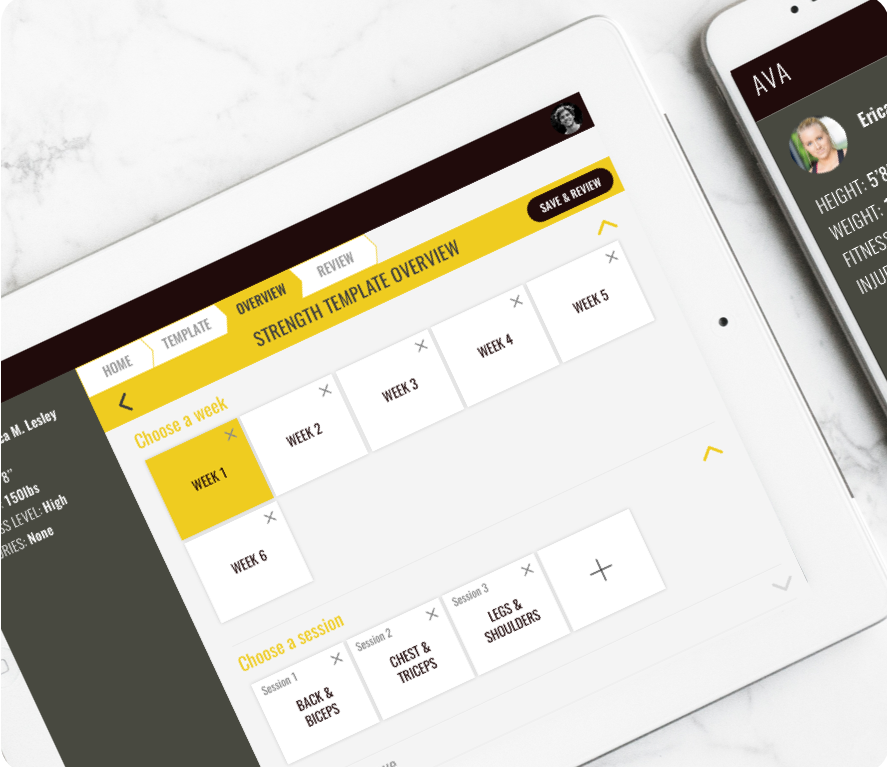AVA
AVA is new paradigm in fitness equipment that enables users to access personalized workouts through a connected machine, capable of delivering variable resistance over various movements and insights about the user's performance.
Project goal
Was to design from scratch an interface that will help personal trainers create customized workouts for clients using AVA enabled exercise machines. Long story short, we had to create the app that programmes the machine.
My role
I contributed as a Product Designer to a team of 7 designers in the process of researching, ideating, prototyping, designing and validating the first proposition for AVA fitness app.
Research phase
Learning about fitness and personal trainers
User interviews insights
Our hypothesis was affirmed: A software tool that connects to AVA’s smart hardware machines will allow trainers to give their clients a more data-driven experience and allow them to scale to train more people at once.
We understood that with a 1:1 programming solution it's easier to understand the pain points on the user experience of personal training: client communication and information management
At the same time, to understand the target user needs, we did 5 User Interviews with personal trainers, where we learnt about their routines and needs..
Market research Insights:
Strength Training programs have more data needs in terms of progression, programming, and monitoring i.e. CrossFit + Wodify
Group cardio sessions have less of a data need and more of a group motivation component i.e. Soulcycle, OrangeTheory
There is a deep desire for the general population to feel like athletes through community and evolved workouts (more functional, less machine) i.e. CrossFit, Tough Mudder, Spartan Race, etc.
With those insights in mind, we created our user personas:
Our design process
Sketching remotely
We did several rounds of UI sketching, working side by side with our remote client.
Discussing our ideas through sketches took us more time before we built the first Lo Fidelity wireframes.
This time helped us arrive to a consensuated Lo Fi prototype.
Ideation
AVA's design problem was abstract and complex, to ideate different possible design solutions, we did a Design thinking workshop.
We also explored alternative systems and existing applications that expressed intuitive data visualizations such as: narratives, mind-maps, timelines (iMovie), Kindle and Google Analytics.
UI and Information Architecture
To structure our UI, we analyzed the task flow of our personal trainer like Brock while programming a workout for his client Erica.
Design decisions
With the insights from the first research phase and the user interviews, we had enough data to make some design decisions:
iPad was chosen as optimal platform for mobility and in-situation use by trainers in sessions with clients
Overall layout is based on iOS guidelines with top and left nav bar
Vertical scroll instead of horizontal timeline
We explored different options with the client's color picks, we decided to eliminate the blues since they relate to other types of apps, we will continue with only one highlight color: yellow.
The conditions of each client (e.g cardiac problems or back pain) will be preloaded and will appear under any relevant moves with ability to edit for that instance
Style Guide
Lo Fidelity Prototype
We created a Lo fi prototype with the wireframes we built after the Ideation phase. We tested it with 4 personal trainers, and this gave us enough insights to move on into the next phase: High Fidelity.
While working on our UI elements, we created a style guide that would feed our designs. To built it, we also worked side by side with the client to understand the adjectives and emotions the brand want to express.
The result
Our final delivery is the first approach to an app that lets personal trainers program workouts for a specific fitness machine in an easy and usable way.
Our goal was very abstract, and the infinite possibilities AVA machine will offer, makes the app very complex.
We tested one more time our final delivery, and we were able to solve the main pain point we identified in previous testings: users were able to go back and forth in the app without problem. They also understood the library and how to use it, while before users didn't understand much it's purpose.
What we've learnt as a team:
The importance of constant communication, specially with a remote client. It demands to be creative and combine different tools at the time for a better understanding.
An abstract problem needs much more iteration during the ideation phase.
A specialized product needs designers to learn about the product and find specific users.
Check out the final prototype:




